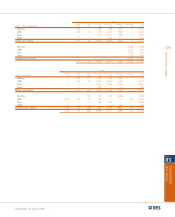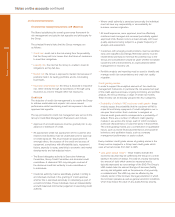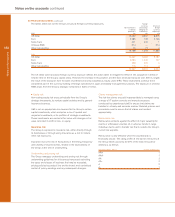RBS 2005 Annual Report Download - page 187
Download and view the complete annual report
Please find page 187 of the 2005 RBS annual report below. You can navigate through the pages in the report by either clicking on the pages listed below, or by using the keyword search tool below to find specific information within the annual report.
section
03
Financial
statements
185
Notes on the accounts
Annual Report and Accounts 2005
•Exposure at default (“EAD”) – these models estimate the
expected level of utilisation of a credit facility at the time of
a borrower’s default. The EAD will typically be higher than
the current utilisation (e.g. in the case where further
drawings are made on a revolving credit facility prior to
default) but will not typically exceed the total facility limit.
The methodologies used in EAD modelling recognise that
customers may make more use of their existing credit
facilities in the run up to a default.
•Credit risk exposure measurement – these models calculate
the credit risk exposure for products where the exposure is
not 100% of the gross nominal amount of the credit
obligation. These models are most commonly used for
derivative and other traded instruments where the amount of
credit risk exposure may be dependent on external variables
such as interest rates or foreign exchange rates.
Risk assets
The Group’s portfolio consists of loans (including overdraft
facilities), instalment credit, finance lease receivables, debt
securities and other traded instruments. In order to encompass
the entire range of products in the Group’s credit portfolios
exposure is monitored using risk assets, which cover
exposures to all these asset and customer types.
Risk asset quality
Internal reporting and oversight of risk assets is principally
differentiated by credit ratings. Internal ratings are used to
assess the credit quality of borrowers. Customers are
assigned credit ratings, based on various credit grading
models that reflect the probability of default. All credit ratings
across the Group map to a Group level asset quality scale.
Provision analysis
The Group’s consumer portfolios, which consist of small value,
high volume credits, have highly efficient largely automated
processes for identifying problem credits and very short
timescales, typically three months, before resolution or
adoption of various recovery methods.
Corporate portfolios consist of higher value, lower volume
credits, which tend to be structured to meet individual
customer requirements. Provisions are assessed on a case by
case basis.
Early and proactive management of problem exposures
ensures that credit losses are minimised. Specialised units are
used for different customer types to ensure that the
appropriate risk mitigation is taken in a timely manner.
Portfolio provisions are reassessed regularly as part of the
Group’s ongoing monitoring process.
Provisions methodology
Under IAS 39 provisions are assessed under three categories
as described below:
Individually assessed provisions are the provisions required for
individually significant impaired assets which are assessed on a
case by case basis, taking into account the financial condition
of the counterparty and any guarantor. This incorporates an
estimate of the discounted value of any recoveries and
realisation of security or collateral. The asset continues to be
assessed on an individual basis until it is repaid in full,
transferred to the performing portfolio or written off.
Collectively assessed provisions are the provisions on impaired
credits below an agreed value threshold which are assessed
on a portfolio basis, to reflect the homogenous nature of the
assets, such as credit cards or personal loans. The provision is
determined from a quantitative review of the relevant portfolio,
taking account of the level of arrears, security and average
loss experience over the recovery period.
Latent loss provisions are the provisions held against the
estimated impairment in the performing portfolio which has yet
to be identified and reported as at the balance sheet date. To
assess the latent loss within the portfolio, the Group has
developed methodologies to estimate the time that an asset
can remain impaired within a performing portfolio before it is
identified and reported as such.
Liquidity risk
Liquidity management within the Group focuses on both overall
balance sheet structure and the control, within prudent limits,
of risk arising from the mismatch of maturities across the balance
sheet and from undrawn commitments and other contingent
obligations. It is undertaken within limits and other policy
parameters set by Group Asset and Liability Management
Committee (GALCO).
The structure of the Group’s balance sheet is managed to
maintain substantial diversification, to minimise concentration
across its various deposit sources, and to contain the level of
reliance on total and net short-term wholesale sources of
funds within prudent levels.
The degree of maturity mismatch within the overall long-term
structure of the Group’s assets and liabilities is also managed
within internal policy limits, to ensure that term asset commitments
may be funded on an economic basis over their life. In
managing its overall term structure, the Group analyses and
takes into account the effect of retail and corporate customer
behaviour on actual asset and liability maturities where they
differ materially from the underlying contractual maturities.
The short-term maturity structure of the Group’s assets and
liabilities is managed on a daily basis to ensure that contractual
cash flow obligations, and potential cash flows arising from
undrawn commitments and other contingent obligations, can
be met as they arise from day to day, either from cash inflows
from maturing assets, new borrowing or the sale or repurchase
of debt securities held.
























